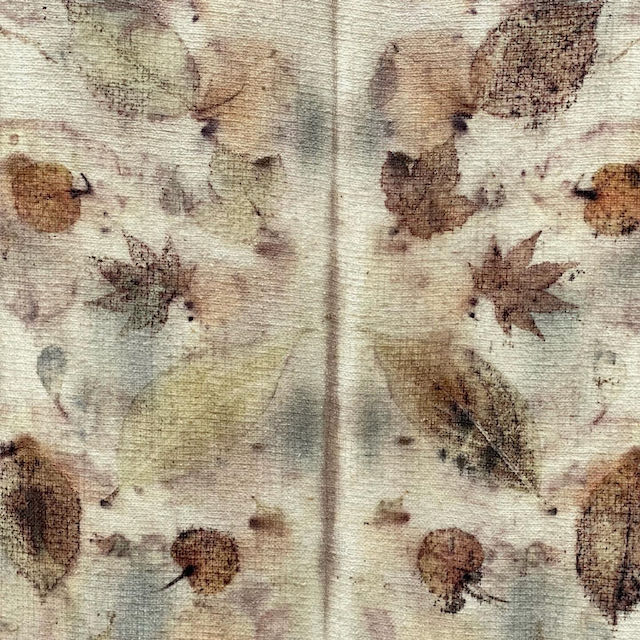Eco Printing
Temple Blessings
I first came across the beauty of 'Eco Printing' via a woman called Rupa Truvedi, the founder of Adiv Pure Nature & Temple Blessings Textiles - a project and sustainable fashion brand based in Mumbai which is centred around the creation of beautiful textiles from plant waste.
Having bought one of her sacred blessing throws, I was intrigued to learn more about the techniques used to create such a variety of texture and pattern, so I decided to contact her in order to find out more!
I received a very warm reply which not only explained how each panel was dyed using pomegranate peel, marigold petals, paper clips & twine, but also what drove her to set up Adiv Pure in the first place and how it supports a growing team of under privileged woman, who have embraced natural dyeing and in turn are able to support their families.
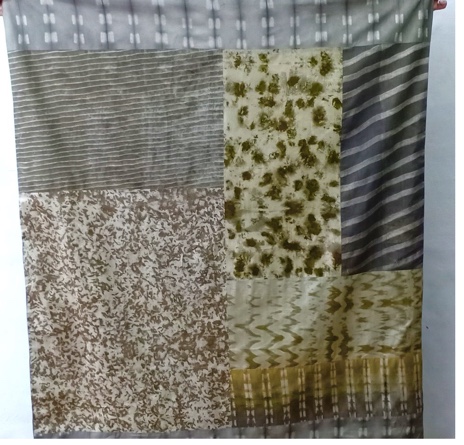
Sacred Blessings Throw
The Temple Blessings project was born from Rupa's obsession to reuse the flower offerings that were traditionally tossed into the sea after being offered at temples. Rupa was keen to explore the dye potential held in every cast-off flower and began her research and experiments of dyeing with marigolds because they are the most important flowers in all rituals.They are also the cause of considerable environmental pollution.
The temple receives over 4 million visitors a month and the collection of the offerings each day is close to 500 kgs. Adiv collects these temple offerings (Nirmalya) weekly and receives roughly 40 to 80 kgs per day . These include an assortment of Marigolds, hibiscus, small quantities of rose and husks of the coconut husks offered at the temple.

So what is Eco Printing?
Eco-printing is a steam contact process originally used to imprint the shape of leaves and flowers on fabrics. The leaves are carefully placed onto cloth, which is bundled and then steamed or boiled to release the dye found naturally within the plant, creating a contact print in the shape of the leaf or flower used. These contact prints are referred to as eco-prints.
Versions of this print technique have been around for centuries, perhaps longer. However, Eco-printing as we know it was essentially developed by textile designer and scholar India Flint.
Eco Printing onto Paper
My first attempt at eco printing was onto paper and I was astounded at the results. Having picked a variety of flowers and leaves, I arranged them onto a good quality, medium weight water colour paper. This is repeated creating a large layered 'sandwich' of pressed flowers, which is bundled tightly together between two ceramic tiles and then steamed.
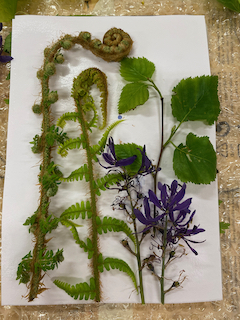
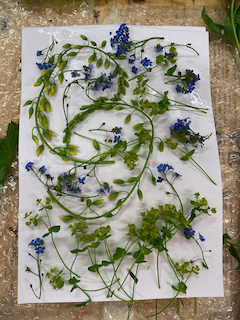
A variety of flowers and plants placed onto paper
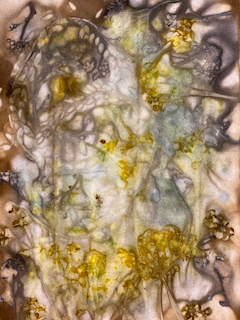
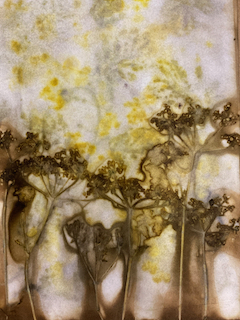

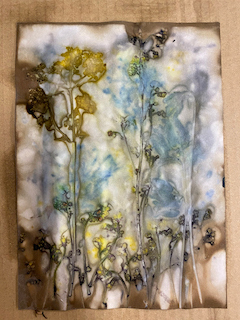
Examples of finished paper prints
Eco Printing onto Silk
Initially I used small samples of cotton to experiment and progressed onto larger pieces of silk and then silk scarves.
Some knowledge and guidance is required, as not all leaves print successfully onto fabric!

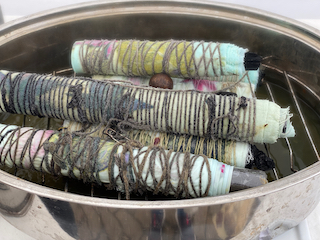
Maple, rose and eucalyptus leaves are used here on noil silk, then carefully folded, rolled tightly around a piece of wooden pole and bound tightly with string or 'bundled', before being placed into a steamer.
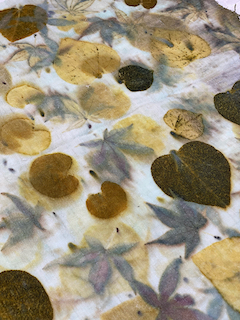
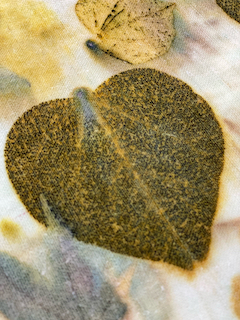
The best results are achieved when there has been a strong contact between the leaves and the fabric.
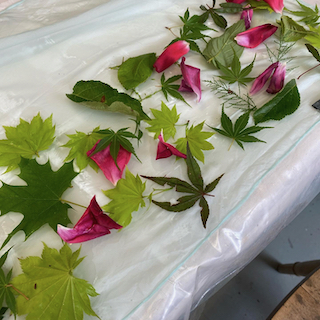
Maple leaves and rose petals are placed onto a silk scarf, carefully folded, bundled & steamed.
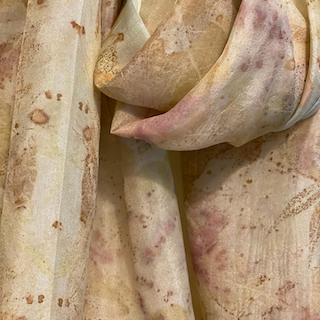
Finished silk scarf
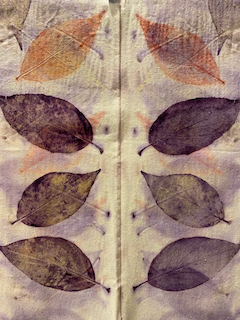
Noil silk dipped in Alum, which acts as a mordant. Leaves are soaked overnight in logwood and brazil wood. The silk is then carefully folded, bundled & steamed.
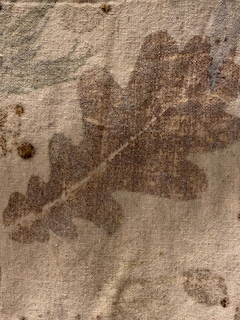
Tea used as a takin 'blanket' which creates these subtle brown imprints

Noil silk which has been soaked overnight in brazil wood. The silk is then carefully folded, bundled & steamed.
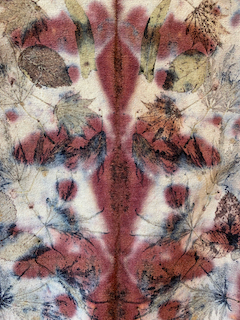
Leaves dipped in ferrous sulphate and placed onto noil silk. The silk is then carefully folded, bundled & steamed.
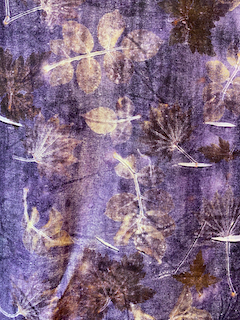
Noil silk mordanted in Alum and cotton 'blanket' soaked in logwood which create this beautiful purple. The silk is rolled around a wooden rod, tied with string and steamed.

Chestnut tanin 'blanket' used to create monochrome prints. The silk is rolled around a wooden rod, tied with string and steamed.
I first came across the beauty of 'Eco Printing' via a woman called Rupa Truvedi, the founder of Adiv Pure Nature & Temple Blessings Textiles - a project and sustainable fashion brand based in Mumbai which is centred around the creation of beautiful textiles from plant waste.
Having bought one of her sacred blessing throws, I was intrigued to learn more about the techniques used to create such a variety of texture and pattern, so I decided to contact her in order to find out more!
I received a very warm reply which not only explained how each panel was dyed using pomegranate peel, marigold petals, paper clips & twine, but also what drove her to set up Adiv Pure in the first place and how it supports a growing team of under privileged woman, who have embraced natural dyeing and in turn are able to support their families.

Sacred Blessings Throw
The Temple Blessings project was born from Rupa's obsession to reuse the flower offerings that were traditionally tossed into the sea after being offered at temples. Rupa was keen to explore the dye potential held in every cast-off flower and began her research and experiments of dyeing with marigolds because they are the most important flowers in all rituals.They are also the cause of considerable environmental pollution.
The temple receives over 4 million visitors a month and the collection of the offerings each day is close to 500 kgs. Adiv collects these temple offerings (Nirmalya) weekly and receives roughly 40 to 80 kgs per day . These include an assortment of Marigolds, hibiscus, small quantities of rose and husks of the coconut husks offered at the temple.

So what is Eco Printing?
Eco-printing is a steam contact process originally used to imprint the shape of leaves and flowers on fabrics. The leaves are carefully placed onto cloth, which is bundled and then steamed or boiled to release the dye found naturally within the plant, creating a contact print in the shape of the leaf or flower used. These contact prints are referred to as eco-prints.
Versions of this print technique have been around for centuries, perhaps longer. However, Eco-printing as we know it was essentially developed by textile designer and scholar India Flint.
Eco Printing onto Paper
My first attempt at eco printing was onto paper and I was astounded at the results. Having picked a variety of flowers and leaves, I arranged them onto a good quality, medium weight water colour paper. This is repeated creating a large layered 'sandwich' of pressed flowers, which is bundled tightly together between two ceramic tiles and then steamed.


A variety of flowers and plants placed onto paper




Examples of finished paper prints
Eco Printing onto Silk
Initially I used small samples of cotton to experiment and progressed onto larger pieces of silk and then silk scarves.
Some knowledge and guidance is required, as not all leaves print successfully onto fabric!


Maple, rose and eucalyptus leaves are used here on noil silk, then carefully folded, rolled tightly around a piece of wooden pole and bound tightly with string or 'bundled', before being placed into a steamer.


The best results are achieved when there has been a strong contact between the leaves and the fabric.

Maple leaves and rose petals are placed onto a silk scarf, carefully folded, bundled & steamed.

Finished silk scarf

Noil silk dipped in Alum, which acts as a mordant. Leaves are soaked overnight in logwood and brazil wood. The silk is then carefully folded, bundled & steamed.

Tea used as a takin 'blanket' which creates these subtle brown imprints

Noil silk which has been soaked overnight in brazil wood. The silk is then carefully folded, bundled & steamed.

Leaves dipped in ferrous sulphate and placed onto noil silk. The silk is then carefully folded, bundled & steamed.

Noil silk mordanted in Alum and cotton 'blanket' soaked in logwood which create this beautiful purple. The silk is rolled around a wooden rod, tied with string and steamed.

Chestnut tanin 'blanket' used to create monochrome prints. The silk is rolled around a wooden rod, tied with string and steamed.

